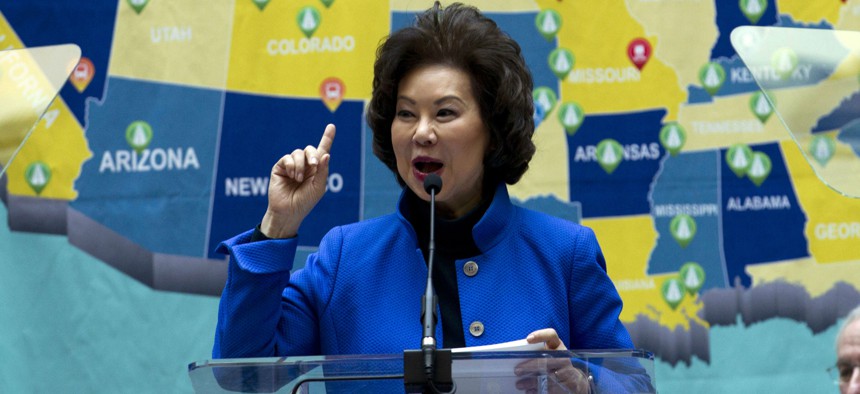FAA Rule Would Let Drones Fly Over People and At Night Without a Waiver

Transportation Secretary Elaine Chao speaks during a major infrastructure investment announcement at transportation headquarters in Washington, Dec. 11, 2018. Jose Luis Magana/AP
The move would greatly open the use of small drones but at least one lawmaker is worried about the privacy of people on the ground.
The Transportation Department is proposing a new rule to allow operators of small drones under 55 pounds to fly at night and over people, conditions that currently require the pilot to obtain a waiver from the Federal Aviation Administration.
The draft rule—which will be posted in the Federal Register and open for public comment once the partial government shutdown ends—sets forth specific guidance for drone operators and manufacturers to comply with, though some privacy hawks are crying foul.
“The department’s approach to new transportation technologies is performance-based, rather than highly prescriptive,” Transportation Secretary Elaine Chao said Monday in a speech before the Transportation Research Board announcing the new rule. “We are not in the business of picking technology winners and losers. Our philosophy is to encourage the widest possible development of safe new transportation technologies, so consumers and communities can choose the mix of options that suits them best.”
Under the proposed rule, rather than requiring operators to get waivers for overnight flights, so long as they have completed the appropriate training courses and the drone is equipped with anti-collision lights.
Operators would also be allowed to fly drones overhead when people are below—a practice that is currently prohibited without a waiver or exemption. The rule would allow overhead flights, depending on risk to the people on the ground. The potential risks are segmented into three categories:
- Category 1: Small drones under 0.55 pounds don’t pose much threat to people on the ground, FAA said, so the rule does not propose any additional restrictions.
- Category 2: For drones over 0.55 pounds, certain criteria must be met, including ensuring a crash involving a person wouldn’t result in serious injury. The proposed rule outlines specific guidelines so manufacturers can build to those specifications, such as not having exposed rotating blades.
- Category 3: The third tier also precludes exposed blades but allows for a higher impact threshold in the event of a crash involving a person.
“To manage this increased risk, Category 3 operations would include three operational limitations not applicable to the other categories of operations,” the rules states. “First, the proposal would prohibit operations over any open-air assembly of people. Second, the operations would have to be within or over a closed- or restricted-access site and anyone within that site would have to be notified that a small unmanned aircraft may fly over them. Third, for operations not within or over a closed- or restricted-access site, the small unmanned aircraft may transit but not hover over people.”
The Transportation Department and FAA have been testing loosening these restrictions as part of a pilot program started last year with 10 public-private partnerships. The pilot worked with state and local organizations to test overhead and nighttime flights for specific uses under controlled conditions.
Sen. Edward Markey, D-Mass., warned of the privacy implications of allowing drones to fly unchecked overhead.
“Drones have the capability to collect treasure troves of sensitive personal information using technologies like facial recognition and automated license plate readers, yet the FAA has failed to establish any baseline privacy protections, despite its obligation to integrate drones into the national airspace,” he said in a statement. “This neglect of American’s right to privacy in the age of drones is unacceptable.”
Once again, Markey is calling for the passage of his Drone Aircraft Privacy and Transparency Act, which he has introduced in the last three Congresses, to no avail.
In both past rules concerning drone operations and the current draft rule, FAA officials note privacy is not within their jurisdiction, which is ensuring “safety and efficiency of aviation operations.” Nonetheless, the draft includes an entire section on privacy issues.
“Although the FAA regulates the safe and efficient operation of aircraft within the [national airspace], the FAA has never extended its administrative reach to regulate the use of cameras and other sensors extraneous to the airworthiness or safe operation of the aircraft in order to protect individual privacy,” the draft rule states.
The document notes the “ongoing debate” around privacy issues but notes the FAA is working with other relevant agencies to “identify, develop and implement appropriate mitigation strategies to address such concerns.” The proposed rule also notes cities and municipalities have better authority and jurisdiction to regulate these issues locally.
In her remarks Monday to the Transportation Research Board, Chao acknowledged the safety and privacy concerns surrounding drones, particularly the in wake of recent events. In December, Gatwick Airport in England was forced to cancel hundreds of flights over three days, as several suspicious drones were flown around the airport.
Alluding to this and similar incidents, Chao announced two additional proposals: the UAS Safe and Secure rule, which will look at major safety and security issues and solicit feedback from stakeholders; and the award of three contracts to commercial stakeholders to develop flight planning, communications and other safety infrastructure for unmanned aircraft.






